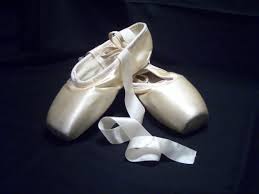A Short History Of Pointe

Ballet was originally developed in the courts of France and Italy during the 16th and 17th century. Dancers would use costuming and movement to tell stories and create scenarios. At first, the performers were only men wearing wigs and tights. In France in the 1600s, women began to study and perform ballet. They wore heavy skirts and heels, which impeded them from attaining the same flexibility or movement as the men.
In the mid 18th century, Maria Tagliona of the Paris Opera Ballet became the first dancer to wear a non-heeled shoe, which enabled her to perform leaps that would not be possible using the traditional heeled shoe. Around the time of the French Revolution, dancers began to wear flat shoes secured with ribbons with pleats on the toes, which made leaps and turns easier.
Throughout the history of ballet, there has been an effort to make the dancers appear lighter, more mystical, and ethereal. In the late 18th Century, the first dancers rose on their toes using an invention of Charles Didelot called a “Flying Machine”, which used wires to lift the ballerinas, making them appear to fly as they leaped. This move was well-received by audiences, and the term “pointe” was used to describe the choreography. Many choreographers began to work on ways to incorporate pointe dancing into their routines without the use of wires.
In the 19th century, Marie Taglioni became the first dancer to dance “en pointe” in her performance of La Sylphide. Her shoes were modified ballet slippers without any real support. The soles were leather with reinforced sides and toes to help the shoes hold their shape. They only allowed her to rise briefly to pointe.
The next incarnation of the pointe shoe occurred in Italy during the 19th century. Dancers such as Perina Legnani would wear shoes with a sturdy, flat platform at the front of the shoe, rather than the pointed end that was previously used. They also included layers of fabric to encase the toes, and a stronger sole. It was at this point that dancers started being asked to do more work en pointe
The modern pointe shoe is often attributed to the influential Russian ballerina Anna Pavlova. She had high arches and slender, tapered feet, which made her more vulnerable to injury while dancing en pointe. To compensate for this, she inserted toughened leather soles into her shoes and created a more stable box for the toe area by flattening and hardening the area containing the toes. This made it easier for her to dance en pointe, but was originally perceived by her colleagues as “cheating”.
Today’s pointe shoes are made of several layers of burlap and canvas, dipped in glue for stiffness, with a final layer of satin. The shoe is held together by three layers of leather and cardboard, called shanks, which are nailed and glued together. They lengthen the line of the leg, build strength in the ankles, feet and toes, and allow dancers to jump higher, sustain poses, and spend more time en point than what was previously possible with the earlier versions of pointe shoes.
For students interested in starting a study of pointe, Main Line School of Dance is now offering an introductory pointe program by teacher referral. Contact us today for more information.